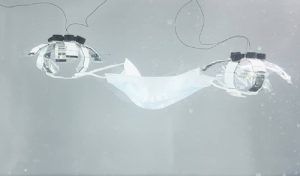
Más del 70% de la superficie terrestre se encuentra cubierta por los océanos. Desgraciadamente, estas grandes masas de agua se encuentran muy contaminadas.
Una de las muchas estrategias pensadas y diseñadas para combatir el riesgo de la contaminación marina y oceánica es el empleo de autómatas que se encarguen de la limpieza de este ecosistema. Sin embargo, algunos prototipos pueden ser voluminosos y ruidosos, debido a sus configuraciones limitadas, afectando así, a la flora y fauna marina.
Ingenieros del Instituto Max Planck de Sistemas Inteligentes (MPI-IS) de Stuttgart han diseñado un robot, inspirándose en una medusa, con el que pretenden poder recoger algún día, los residuos del fondo marino. Este Jellyfish-Bot, casi insonoro, es capaz de atrapar objetos bajo su cuerpo sin ningún contacto físico, permitiendo interacciones seguras en entornos delicados, como los arrecifes de coral o los bosques de posidonia.
Este robot presenta el tamaño aproximado de una mano y cuenta con seis brazos electrohidráulicos que funcionan como músculos artificiales para el impulso.
“Cuando una medusa nada hacia arriba, puede atrapar objetos a su paso al crear corrientes alrededor de su cuerpo. De este modo, también puede recoger nutrientes. Nuestro robot también hace circular el agua a su alrededor. Esta función es útil para recoger objetos como partículas de desecho. A continuación, puede transportar la basura a la superficie, donde posteriormente puede reciclarse. También es capaz de recoger muestras biológicas frágiles, como huevos de peces. Mientras tanto, no tiene ningún impacto negativo en el medio ambiente circundante. La interacción con las especies acuáticas es suave y casi sin ruido”, según comenta Tianlu Wang, postdoctor del Departamento de Inteligencia Física del MPI-IS y primer autor de la publicación.
Estos robots funcionan solos o por combinación de varios, alcanzando una velocidad de hasta 6.1 cm/s y necesitando únicamente 100mW de electricidad. Por ahora, necesitan un cable para funcionar, pero el equipo ya está avanzando en el prototipo para configurar un autómata con batería y comunicación inalámbrica.
Los mares y océanos se encuentran en una situación de extrema urgencia, y las ciencias e ingenierías como la robótica, pueden ser unas grandes aliadas para combatir y revertir esta situación.
__
JELLYFISH ROBOT
More than 70% of the earth’s surface is covered by oceans. Unfortunately, these large bodies of water are heavily polluted.
One of the many strategies conceived and designed to combat the risk of marine and ocean pollution is the use of automatons to clean up this ecosystem. However, some prototypes can be bulky and noisy due to their limited configurations, thus affecting marine flora and fauna.
Engineers at the Max Planck Institute for Intelligent Systems (MPI-IS) in Stuttgart have designed a robot, inspired by a jellyfish, with which they hope to one day collect debris from the seabed. This almost soundless Jellyfish-Bot is capable of trapping objects under its body without any physical contact, allowing safe interactions in sensitive environments such as coral reefs or posidonia forests.
This robot features the approximate size of a hand and has six electrohydraulic arms that function as artificial muscles for momentum.
“When a jellyfish swims upwards, it can catch objects in its path by creating currents around its body. In this way, it can also collect nutrients. Our robot also circulates water around it. This function is useful for collecting objects such as waste particles. It can then transport the garbage to the surface, where it can later be recycled. It is also capable of collecting fragile biological samples, such as fish eggs. Meanwhile, it has no negative impact on the surrounding environment. The interaction with aquatic species is smooth and almost noiseless,” according to Tianlu Wang, a postdoc in the Department of Physical Intelligence at MPI-IS and first author of the publication.
These robots operate alone or by combination of several, reaching a speed of up to 6.1 cm/s and needing only 100mW of electricity. For now, they need a cable to operate, but the team is already making progress on the prototype to configure a battery-powered automaton with wireless communication.
The seas and oceans are in a situation of extreme urgency, and science and engineering, such as robotics, can be great allies to combat and reverse this situation.
__

